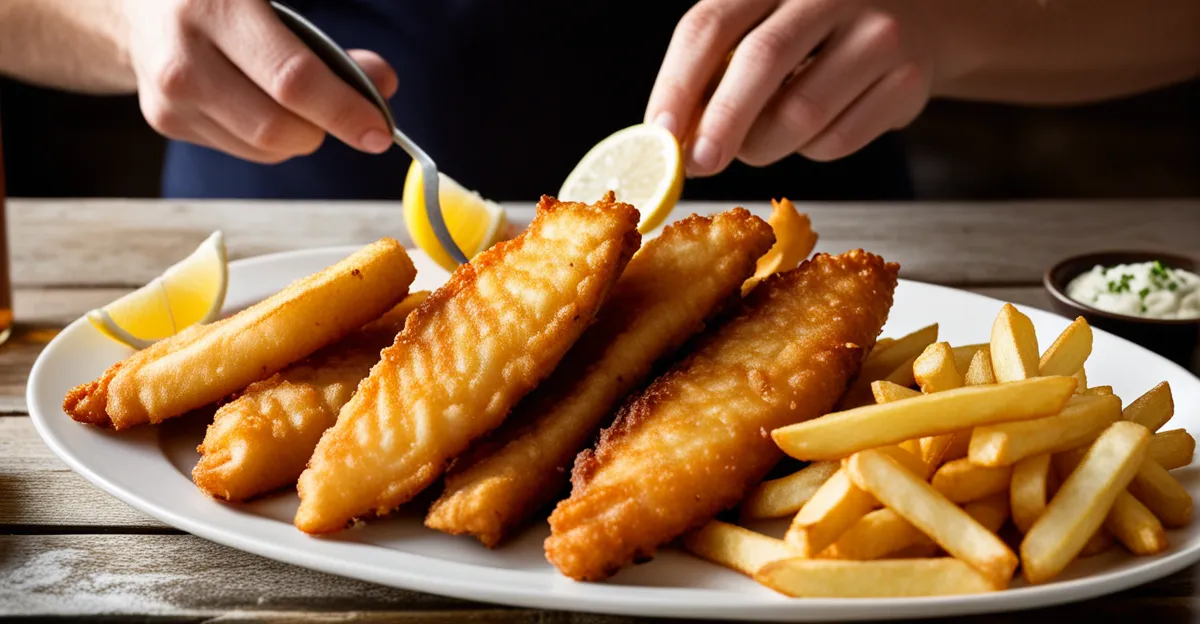Selecting the Right Fish
When choosing fish for your beloved fish and chips, the types of fish play a crucial role. Cod and haddock are traditionally favored for their flaky texture and mild flavor, making them ideal for this classic dish. However, it’s equally important to consider fish such as pollock or whiting, which provide a delightful taste and are often more readily available.
Another vital aspect of fish selection is ensuring it is sustainable fish. Sustainable choices support responsible fishing practices, reduce environmental impact, and help maintain aquatic ecosystems for future generations. Look for certifications from trusted organizations like the Marine Stewardship Council or similar bodies for peace of mind when shopping.
Additional reading : What are the key ingredients for a perfect bangers and mash?
To guarantee freshness and quality, always check the fish for a firm texture and a sea-fresh smell. The eyes should be clear and bulging, with moist, bright red gills. These tips for freshness and quality help you choose fish that will enhance the overall experience of your homemade fish and chips. Avoid fish with a mushy feel or a pungent fishy odor, as these are signs of spoilage. With these considerations, you’ll ensure each bite is not just delicious but also respectful of our oceans.
Preparing the Batter
Creating the perfect batter is essential for achieving crispy and delightful fish and chips. Many enthusiasts swear by the classic beer batter, which adds a light, airy texture due to the carbonation. Other batter recipes, like a simple flour and water mix, can also create a crunchy coating, but may not provide the same richness as beer batter. For those who prefer an alternative to alcohol, sparkling water is an effective substitute to ensure a similarly airy texture.
In the same genre : How do you make a perfect scone with clotted cream and jam?
Key Ingredients for Light and Crunchy Batter
The essential ingredients for a traditional batter include flour, liquid (beer, sparkling water, or simply water), and sometimes baking powder. The combination of these elements creates the foundation for smooth, thick batter that adheres to the fish. If you’re aiming for extra crispiness, a touch of cornstarch can also work wonders.
Steps for Ensuring Proper Texture and Flavor
To achieve a batter that’s both crisp and flavorful, it is crucial to keep certain tips in mind:
-
Chill the Liquid: Ensure your chosen liquid is chilled before mixing with the dry ingredients, as this helps form light, delicate bubbles in the batter.
-
Minimal Mixing: Combine the ingredients gently and avoid over-mixing to maintain the airiness essential for the desired crispy texture.
-
Rest the Batter: Letting the batter sit for a few minutes before coating the fish allows the ingredients to amalgamate, improving the flavour profile.
Crafting the perfect batter might take practice, but these tips will set you on the path to consistently crunchy, delicious results.
Frying Techniques
Frying is where the magic happens in crafting exquisite fish and chips. The key lies in mastering frying methods for consistent results. When you deep fry, ensuring an even cook is paramount. This involves submerging the fish and chips fully in hot oil, allowing even heat distribution. However, achieving the right oil temperature is critical. Traditionally, the oil should be heated to about 350°F to 375°F. This precise temperature ensures a crispy exterior while keeping the inside tender.
Proper management of oil temperature cannot be understated. If the oil is too cool, the batter will absorb excess oil, resulting in soggy texture. Conversely, too hot oil can lead to uneven cooking and, worse, burnt outsides. To maintain optimal temperatures, a reliable kitchen thermometer is an invaluable tool.
Considering safety tips is just as crucial when frying at home. First, never fill the pot more than halfway with oil to prevent dangerous splattering. Keep a close eye on the cooking process, and always have a fire extinguisher or baking soda nearby, just in case. By being cautious and attentive, you’re sure to enjoy a flavorful and safe cooking experience.
Choosing the Perfect Potatoes
Selecting the right potatoes is an essential step in achieving that perfect chip. Potato selection is crucial as it affects the texture and taste of your chips. For the best results, opt for high-starch varieties like Russet or Maris Piper potatoes. These types of potatoes become wonderfully fluffy on the inside while maintaining a crispy exterior when fried.
Techniques for Cutting and Soaking Potatoes
Once you’ve chosen the ideal potato variety, how you cut and prepare them can significantly impact the final result. To ensure even cooking, cut the potatoes into uniform sizes, typically about 1 centimeter thick. Before frying, soak the cut potatoes in cold water for at least 30 minutes. This process helps remove excess starch, preventing the chips from sticking and encouraging crispiness.
Factors Affecting Chip Texture and Taste
Several factors influence the texture and flavor of your chips. Controlling water content is integral, as excess moisture can lead to soggy fries. Dry the potatoes thoroughly after soaking. Additionally, consider double-frying your chips: first at a lower temperature to cook through, then at a higher one to achieve a golden and crisp exterior. By paying attention to these details, you can create chips that are the perfect complement to your homemade fish and chips.
Achieving Optimal Texture and Flavor
The quest for exceptional fish and chips doesn’t end with the perfect fry. Achieving optimal texture and flavor requires additional techniques and thoughtful approaches. Here are some cooking tips that ensure crispy, delectable results every time.
Firstly, focus on seasoning as a critical element for flavor enhancement. Salt is your friend—generously season both the fish and chips right after frying. This helps retain the crispiness while adding depth to the taste. For a twist, try using sea salt or even smoked salt for added complexity.
Balancing textures between the fish and chips is crucial. You want the fish to be tender and flaky inside while boasting a crispy golden coating. To achieve this, rest the fish on a wire rack after frying, rather than on paper towels. This allows excess oil to drip away, preserving that beloved crunch.
Lastly, consider lightly dusting the fish with a touch of flour before dipping in the batter. This simple step aids in better batter adhesion, providing an even crisper finish. With these techniques in your culinary arsenal, you’re well on your way to mastering the art of making perfect fish and chips.
Side Sauces and Accompaniments
Fish and chips, a celebrated dish, are often paired with a selection of alluring sauces. Among the most popular is the classic tartar sauce, whose creamy texture and tangy flavor perfectly complement the meal. To make this at home, simply combine mayonnaise, chopped pickles, lemon juice, and a hint of capers. This homemade version can be tailored to your taste by adjusting the balance of tart to smooth to achieve the perfect consistency.
Beyond tartar sauce, consider serving your fish and chips with a zesty lemon aioli or a robust malt vinegar to enhance the flavor profile. These alternative sauces bring distinct angles of spice and acidity to the plate, adding interest to each bite.
No meal of fish and chips is complete without some thoughtful side dishes. Classic picks include mushy peas or a fresh coleslaw to balance the dish with a touch of lightness. For those seeking comfort, a side of baked beans can add warmth and familiarity. By incorporating these sauces and sides, your fish and chips will transform into a meal that delights the senses, offering varied textures and flavors.
Variations on Traditional Recipes
Innovation can transform classic fish and chips into a culinary adventure. For those eager to experiment, exploring recipe variations can breathe new life into this time-honoured dish. Traditionalists might balk, but introducing different fish alternatives can cater to numerous dietary options. Consider using salmon or halibut if you’re craving a richer flavor, or for those preferring a milder taste, tilapia and flounder are excellent substitutions. These alternatives still hold their own in a frying pan, offering delicious diversity.
Got dietary restrictions? No problem. Chic peas flour or gluten-free batter can seamlessly replace regular flour for gluten-free variations of your favorite crispy fish. To draw in other flavors, consider adding different herbs or spices to the batter, such as dill or paprika, which bring a zesty kick.
Customizing recipes allows you to tailor the flavor profiles to specific tastes. Perhaps you like a piquant twist, then infuse your batter with a touch of freshly ground black pepper or garlic. Or go international; think panko breadcrumbs for a Japanese-inspired crunch or lemon zest for a Mediterranean feel. Embracing these diverse options can elevate fish and chips beyond its British origins, creating a truly personalized dish.







